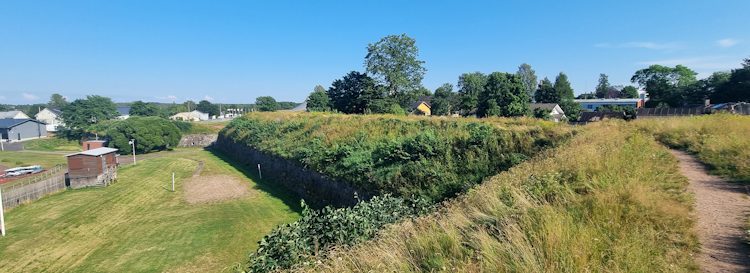We have driven past the Hamina Fortress at least a dozen times but we never seemed to have the time to stop and explore it. Now, we finally made it an official stop and went to see why it’s such a loved site. There is a narrow walkway along the tops of Hamina Fortress curtain walls, which you can follow if you’re careful. The drop is very steep so make sure to keep to the path. We took the path on the curtain walls towards the Hamina summerpark (Haminan kesäpuisto).
The Hamina Fortress can be accessed from several points. We decided to have coffee at Hamina Town Hall and enjoy the unique circular design of the town before walking to the fortress. We started at Hamina Bastion, which serves nowadays as a cultural and event venue for events such as the famous Hamina Tattoo (military music event).
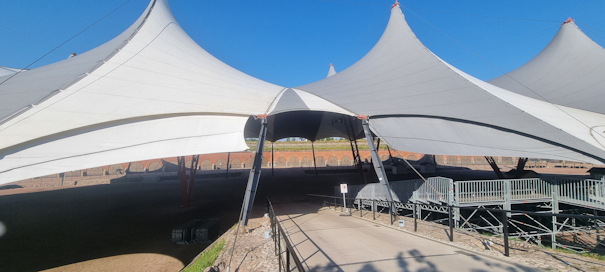
The large central Bastion was constructed in the early 1800s. This included a 240m embankment with 58 brick casemates (casemate = fortified gun emplacement or armoured structure from which guns are fired).
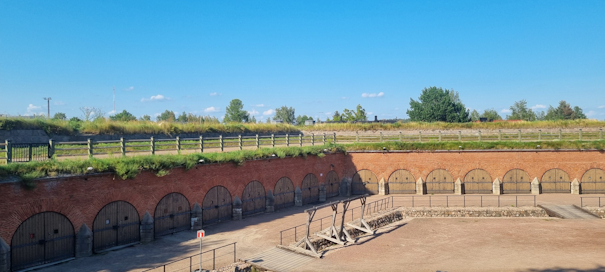
Star-shaped bastion design
The Hamina Fortress has six outward‑pointing bastions, each named after Finnish towns that had fortifications at the time: Savonlinna, Hamina, Helsinki, Turku, Hämeenlinna, and Lappeenranta. The fortress features curtain walls, moats, and traces of outer defensive works such as ravelins.
Those who are more well versed in military fortress designs will be able to appreciate the renewals and updates Russians made to Hamina Fortress in the 1790s. This included the caponiers, which is a type of roofless defensive structure alongside the outer walls of fortresses. We actually stood on top of one of these caponiers while walking on the curtain wall.
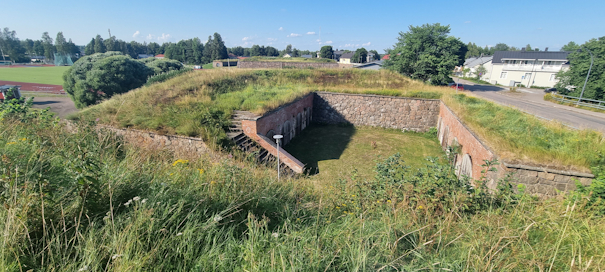
We walked towards a large indent on the inside of the curtain walls and eventually landed down to “earth level”. Then, we noticed that the indent was actually a gun powder reserve, which was obviously located near defensive positions along the fortress walls. These gun powder reserves were built in 1785, and were used as communications centres and gas shelter but also, less glamorously, as a potato shed.
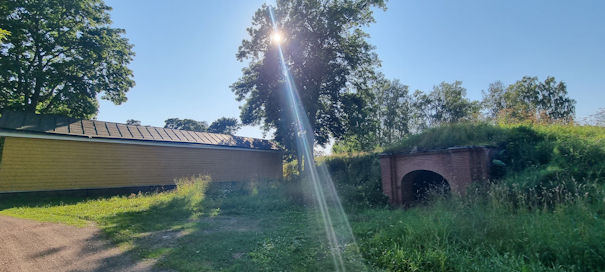
Enjoying Hamina while exploring fortress
The area surrounding the fortress is made up largely of low wooden buildings which were built mainly during the 1800s. Some were even earlier, built in the 1700s. The final stop for us was Hamina Summer park (Haminan kesäpuisto), which was founded on the bastion area in the 1850s. The leafy green colours almost masked the massive curtain walls surrounding large parts of the park.
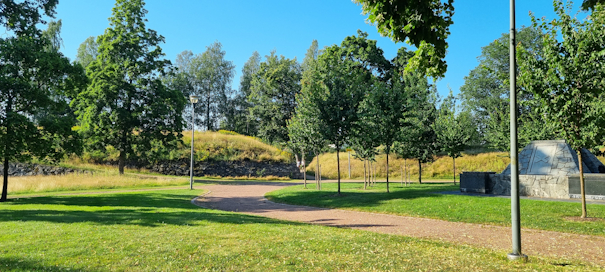
History of Hamina Fortress
Hamina Fortress is a star-shaped bastion fortress, and its unique circular layout was influenced by Italian Renaissance (more specifically, the town of Palmanova). The fortress was designed by Swedish general Axel von Löwen. The medieval merchant town of Vehkalahti stood in the area first, and it was later renamed Hamina. When the fortress was being built, the entire town of Hamina was designed alongside it: even now, the centre of Hamina is circular which is very rare.
After the Great Northern War (1700–1721), Sweden (under which Finland was until 1809) lost the nearby fortress of Vyborg to Russia. To protect southeastern Finland, Sweden decided to build a new stronghold at Hamina in 1722. Construction of the Hamina Fortress began in the 1720s and was completed in stages, with the fortress playing a key role in defending the eastern frontier alongside a fortress in Lappeenranta. However, the half-built Hamina Fortress was captured by Russia during the Russo-Swedish War of 1741–1743.
After a treaty was signed between Russia and Sweden in 1743, Hamina became part of the Russian Empire. The fortress was modernized under Russian rule and housed a garrison for nearly 200 years. Later, in 1809, when Sweden ceded all of Finland to Russia, and Finland became an autonomous Grand Duchy, the military importance of Hamina diminished.
Directions to Hamina Fortress
Address: You can type Hamina Bastioni on your navigator. Alternatively, you can type in the exact address Raatihuoneenkatu 12, 49400 Hamina.
How to get there:
- Car: There are parking spaces all over the centre of Hamina. There are also large carparks by the supermarkets (with time limits).
- Bicycle: You can’t cycle on the fortress walls so the best thing is to park your bicycle at a safe location.
- Public transport: You can get to Hamina via Kotka town. Buses from Kotka run quite often. The closest bus stop is Hamina market square or Haminan tori. Check the Route Planner for timetables. You will have to walk 700m from Hamina market square bus stop to the Bastion.
Accessibility: The area is partially accessible. The paths along the high walls are relatively narrow so caution should be taken. The best and most accessible area to view the fortress walls is in Haminan kesäpuisto park or near the Bastion.
When to go: The fortress is open 24/7. You can visit at any time of the year. When there is snow, make sure to be extra vigilant as snow and ice may cover holes and/or make areas very slippery.
Facilities: There are no official facilities in the area.
More to explore
If you are interested in military history such as the famous Salpalinja fortress sites, you should visit Luumäki nearby.

